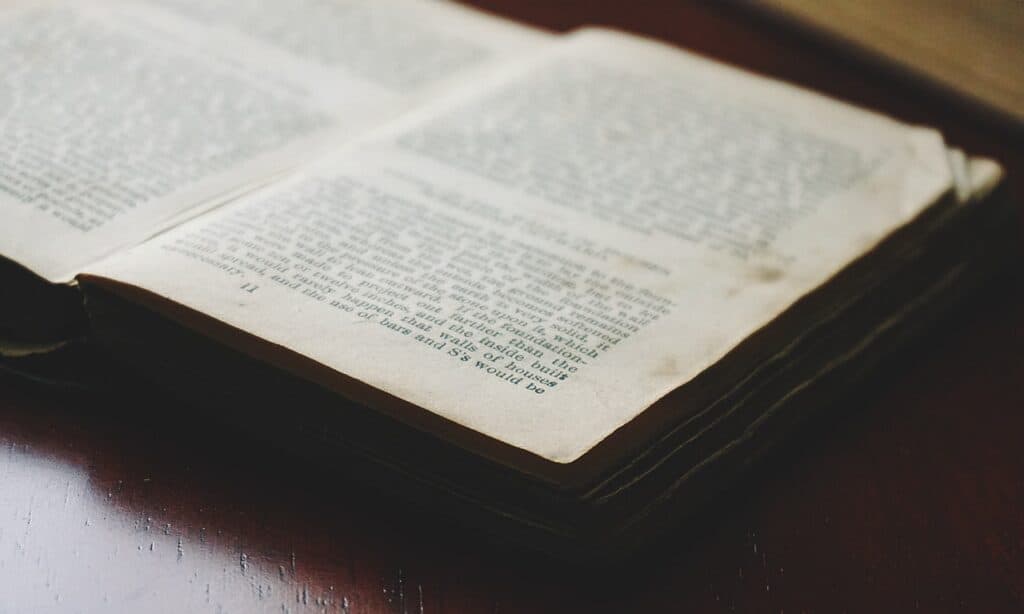Are you learning about the Shakespearean play ‘Much Ado About Nothing’ for English and struggling to come up with an analysis? We’ll walk you through a summary of Much Ado About Nothing with its context, themes, characters and more to help you with your analysis.
PLUS we’ll also provide a free sample analysis table (also called a TEE Table) and a sample paragraph that you can download!
Let’s get started on your analysis of Much Ado About Nothing!
Much Ado About Nothing Summary
Key Characters in Much Ado About Nothing
Context
Themes Explored in Much Ado About Nothing
Analysis of Much Ado About Nothing
Studying this Text for VCE English
Summary of Much Ado About Nothing
Much Ado About Nothing follows two romantic relationships in Messina after winning a war.
The central relationship is between Hero and Claudio; the couple mirrors Elizabethan gender conventions. The second relationship is between Beatrice and Benedick, both of them are witty characters who swore against marriage at the beginning of the play.
Image sourced from No Sweat Shakespeare
Act 1
A messenger reports to Leonato, Hero’s father and Beatrice’s uncle, that Don Pedro (the Prince of Aragon) has arrived in Messina. Accompanying Don Pedro are Claudio, Benedick, Balthasar, and Don John.
Beatrice says to Benedick “I wonder that you will still be talking, Signior Benedick, nobody marks you” and they begin their first round of verbal sparring.
Now that they have won the war, Claudio tells Benedick that he sees Hero without a “soldier’s eye” and has fallen in love with her. Benedick, who spurns the idea of marriage, complains that there are not enough bachelors in the world.
He also notes that “her cousin [Beatrice], an she were not possessed with a fury, exceeds her as much in beauty as the first of May doth the last of December”, implying that he finds Beatrice much more beautiful than Hero.
Act 2
Leonato holds a masquerade ball to celebrate the end of the war. Don Pedro, disguising as Claudio, proposes to Hero.
Don John and Borachio pretend that they mistake Claudio for Benedick. They tell him that Don Pedro is wooing Hero for himself. This triggers Claudio’s jealousy and he remarks that when it comes to love, you can trust no one.
Nevertheless, Don Pedro announces the good news: the engagement of Claudio and Hero is arranged.
Don John hears of Claudio’s and Hero’s engagement, and is also jealous. His minion, Borachio, comes up with a scheme to ruin their marriage.
Borachio and his lover, Margaret (Hero’s lady-in-waiting) will meet at Hero’s window, tricking Claudio into believing that it is Hero with her secret lover. Don John offers Borachio a thousand ducats to carry out the scheme.
Conrade, another of Don John’s minions, is shocked at the bribe but, Borachio only notes that “when rich villains have need of poor ones, poor ones may make what price they will”.
Claudio, Don Pedro, Leonato and Balthazar enter the garden, while Benedick hides behind an arbour (a small group of trees). Aware that Benedick is listening, Don Pedro’s group talk about Beatrice’s love for Benedick. Leonato swears that Beatrice “loves him with an enraged affection…past the infinite of thought”.
Benedick believes their words to be true as Leonato, the old Governor of Messina, would never participate in a childish trick. He realises that he must confess his love for Beatrice, saying “When I said I would die a bachelor, I did not think I should live till I were married”.
Act 3
The female characters play a similar trick on Beatrice. Hero tells Margaret to send for Beatrice and remarks to Ursula that “Cupid’s crafty arrow…only wounds by hearsay”. When the three notice Beatrice sneak up on them, they begin speaking about Benedick’s “love” for Beatrice.
Beatrice overhears that Ursula and Hero speak of Benedick as wise, noble, young, handsome, and that he loves ‘‘loves Beatrice . . . entirely’’. Benedick and Beatrice are thus duped into falling in love with each other.
Don John goes to Claudio and Don Pedro and claims that Hero has been unfaithful. He tells them to view Hero’s chamber window in the evening and see Hero with one of her lovers.
Don Pedro also makes fun of Benedick’s newfound fashion sense, his shaved face, perfume, paint and interest in playing music.
That very evening, they spy on Margaret in Hero’s clothes speaking to a man. Claudio believes this to be Hero, declaring that ‘‘in the congregation where I should wed, there will I shame her’’. Don Pedro commits that ‘I will join with thee to disgrace her’’.
Meanwhile, Hero prepares for her wedding. Ursula and Margaret remark that Hero’s dress exceeds that of the Duchess of Milan’s gown.
Act 4
Until Act 4, the two couples have not encountered any obstacles to their romance. This is broken in Act 4 when Claudio believes Hero to be cheating on her.
Claudio and Hero stand before the friar at their wedding. Claudio interjects the proceedings and claims that he has been deceived by her chaste, maidenly appearance. He publicly disgraces her by accusing that she “knows the heat of a luxurious bed” and is a “rotten orange”.
Leonato, horrified of the accusations against Hero, asks for a dagger to kill himself with. He also wishes that Hero would die so that he will not have to kill her himself.
The accusations supposedly cause Hero to die of shock.
Benedick and Beatrice remain in the church after everyone has left. Benedick declares his love for Beatrice and asks if he can do anything for her to prove his love. Beatrice replies “Kill Claudio” and, after initial hesitation, he agrees to avenge Hero’s slander.
Only the Friar and Beatrice truly believe Hero’s innocence. The Friar devises that Leonato, Beatrice and Benedick will pretend that Hero is dead until Claudio’s accusations are either confirmed or proven false.
Dogberry and Verges overhear Borachio and Conrade’s conversation. The two watchmen learn that Don John has paid him a thousand ducats for tricking Claudio to believing that Hero is disloyal. Dogberry and Verges arrest the pair.
Act 5
Dogberry interrogates Borachio and Conrade and, after some difficulty, intends to give their confession to Leonato.
A grieving Leonato and Claudio almost enter into a brawl, with Antonio and Don Pedro joining. Benedick comes and breaks the fight. He challenges Claudio to a duel for Hero’s honour. Claudio accepts.
Dogberry arrives with Borachio and Conrade, where the two confess their crimes.
Leonato forgives Claudio on three terms: he confirms Hero’s innocence, puts an epitaph on her tomb and accepts to wed Leonato’s “niece” in Hero’s place. At the second wedding, Claudio is presented with a masked woman who turns out to be Hero. He is full of joy.
Benedick and Beatrice join and share the wedding day, even after learning that they had been duped into falling in love.
The play ends with a merry dance and Don John due to stand future trial.
Key Characters in Much Ado About Nothing
Hero: A docile young woman. Daughter of Leonato and cousin of Beatrice. After being publicly shamed by her betrothed, Claudio, she is hidden away by her father until the slander proves false.
Claudio: A young Florentine soldier. He falls in love with Hero after coming home from the war. He, however, becomes cruel and proposes to kill her after Don John tricks him to believe that she is unfaithful. By the end of the play, he marries her.
Beatrice: A witty, headstrong young woman who does not want to marry at the beginning of the play. Cousin of Hero. She and Benedick are in a “merry war” where they have “skirmishes of wit”. She is duped into falling in love with Benedick by Hero and Ursula.
Benedick: Best friend of Claudio and Lord of Padua. An aristocratic soldier who has recently been fighting under Don Pedro. He is boorish at the beginning of the play and he swears he will never fall in love or marry. He becomes less temperamental when he falls in love with Beatrice.
Don Pedro: The Prince of Aragon. Pedro woos Hero for Claudio.
Don John: The bastard brother of Don Pedro. He is resentful and plots to break Claudio’s marriage.
Leonato: Hero’s father and Beatrice’s uncle. He is the local governor and uses his household like a miniature court for visiting princes.
Antonio: Leonato’s brother and poses as father to Leonato’s “niece”.
Dogberry: A constable of Messina. Inarticulate, cannot get his words straight and lenient with criminals under his watch.
Borachio: Don John’s accomplice and villain. Lover of Margaret, who is Hero’s lady-in-waiting. He masterminds his plot to slander Hero and carries it out for Don John’s bribe. By the end of the play, he confesses to his crime while he is drunk.
Conrade: Another of Don John’s minions. He, along with Borachio, confess to his treacherous crimes.
Context of Much Ado About Nothing
The social order of Messina offers a direct representation of Elizabethan values. Importantly in Much Ado, Shakespeare reflects the pervasive patriarchal feudal system of the Elizabethan era to fuel the conflict of the play.
Elizabethan gender divisions
Women
Claudio’s public rejection and disgrace of Hero is only effective because Messina is a direct representation of the societal values concerning Elizabethan women.
Under the Elizabethan patriarchal value system, Elizabethans praised reason and human thought, and saw women as the opposite of these values and were to be placed under male control.
A woman who is silent, like Hero, would convey that she is a dutiful and modest maid — this is contrary to Beatrice who Don Pedro claims “most offends”. Even then, Hero’s symbolic death and rebirth signifies the value of purity that Elizabeth women had to uphold for marriage.
Women were deemed a man’s possession. Infidelity and disloyalty was therefore the gravest wound to a man’s self-esteem. On the other hand, Claudio was content for Don Pedro to woo Hero for Claudio’s sake.
Men and The Courtier
Much Ado About Nothing engages with Baldassare Castiglione’s The Courtier, which was a profound book of advice for Elizabethan men who were close to the King’s court.
The ideal values of “the Courtier” character favoured more civilised and refined behaviour. Despite Benedick’s boorishness at the beginning of the play, he balances his loyalty between Don Pedro’s group and Beatrice’s love, his soldier and court life, and has a refined wit.
This is compared to Don Pedro and Claudio, who are foolish and violent, and approach love like a war.
Class Distinctions
The main characters of Much Ado About Nothing are of the aristocracy.
There is little to critique the aristocratic class, besides the character of the “low-born” Borachio who dupes his superiors. When Don John bribes him to carry out his plan to break Claudio and Hero’s engagement, he states “For when rich villains have need of poor ones, poor ones may make what price they will.”
While Shakespeare negotiates the status of aristocratic women, lower-class characters are reflected as manipulative and willing to carry out deceptive tasks for money.
Themes Explored in Much Ado About Nothing
Beneath the lighthearted tone of Much Ado About Nothing, Shakespeare’s parallel between warfare and romance, the subject of the slandered woman and the struggle for love bring out interesting themes:
- Love, courtship and war
- Marriage and freedom
- Infatuation, distrust and deception
How to Analyse Much Ado About Nothing in 3 Steps (Analysis)
Often students will try to start with their thesis when trying to answer an essay question. Instead, start with your analysis! You need to equip yourself with the knowledge of your text before you can answer anything about it.
After you’ve analysed your text, you can draw ideas from it, then you can build your thesis!
We’re going to walk you through creating an analysis for ‘Much Ado About Nothing’ in three simple steps!
Step 1: Choose your example
The best way to choose an example is to find a technique. The technique is the key to unlocking deeper meaning in a text, which you will need in your analysis.
We have chosen to look at a quote from Act 1 Scene 1 where Benedick comments on Beatrice’s beauty:
“an she were not possessed with a fury, exceeds her as much in beauty as the first of May doth the last of December.”
Step 2: Identify your technique(s)
When trying to find a technique within your example, it’s not about finding the fanciest technique or just any old technique for that matter!
It’s about identifying a technique which will enable you to say something about your idea that’s interesting and can contribute to your argument and analysis.
Try to focus on finding examples with techniques which unveil a deeper meaning like metaphors, similes, figurative language, connotations, symbolism and recurring motifs. Other techniques like alliteration and repetition are a bit harder to find a deeper meaning in!
We have identified 3 techniques in the quote above: connotations, simile, free verse.
It’s always great to try and find multiple techniques in your quotes as it allows you to take your analysis up a notch!
Step 3: Write the analysis
When you write the analysis, it is important to always focus on what the effect of the technique is. One of the worst things you can do when writing analysis is technique labelling. Technique labelling would look like this:
In Benedick’s free-verse speech, his simile “an she were not possessed with a fury, exceeds her as much in beauty as the first of May doth the last of December” carry connotations of the summertime to demonstrate his attraction to Beatrice despite her anger.
Instead of this we need to flesh out how each of those techniques get us to our point. We should explore how Benedick does not flatter Beatrice, as Claudio does to Hero.
Instead, in a realistic light, he appreciates all sides of her character. This would look like:
Benedick describes Beatrice’s beauty in a more realistic simile: “an she were not possessed with a fury, exceeds her as much in beauty as the first of May doth the last of December”; his seasonal connotation of a tender summer accepts Beatrice’s outward fury, even if it is against the Elizabethan female ideal.
Studying this text for VCE English Unit 3 – Area of Study 1: Reading and Creating Texts
If you are studying this text as a part of VCE Unit 3, Area of Study 1, Reading and Creating Texts, there are a few more things to keep in mind!
One of the important aspects of this Area of Study is having your own interpretation of the text. This means that you can’t just state what is obvious about the text, instead, you need to make an argument. To have an interpretation of the text, you need to make an argument about something in the text which is not blatantly obvious.
For example, saying “Much Ado About Nothing shows how marriage can constrain individual freedom” is not a strong interpretation, because that’s obvious! Everyone can see that from reading the plot synopsis. Instead, try to make your interpretations something you have to dig a little deeper in the text to find. For example, we have argued:
“Shakespeare’s Much Ado About Nothing demonstrates the institution of marriage, while often simply felt as constraining, can proffer a greater capacity for complexity and happiness. “
This is a strong interpretation because it took reading into numerous quotes and signs and symbols to develop it. Below, we have explained how to come up with your own interpretation.
Step 1: Identify techniques in your text
Techniques are they key to unlocking the deeper hidden layers of meaning in your text, which is exactly what you want to find when developing your own interpretation.
Things like metaphors, similes, symbolism and recurring motifs are great things to look for. Things like alliteration and sound techniques will be less helpful in allowing you to uncover deeper meanings initially.
Step 2: Analyse the techniques
In this step you want to ask yourself:
- Why have they chosen to use this specific technique?
- Why was the word choice here important?
- Is there something deeper behind this quote (connections to the text, the context, the lesson readers learn)?
Step 3: Find patterns in what your analysis is saying
Once you find patterns in what your analysis is saying, or in other words, patterns in the hidden meanings within the text, you have yourself an interpretation!
For example, when we were analysing ‘Much Ado About Nothing’, we noticed a transformation of Benedick’s character from a misogynistic soldier who spurned marriage to a happier and complex man who stood up for Beatrice at the cost of being the laughingstock in Don Pedro’s group.
While Shakespeare does convey the dangers of an unhappy marriage, Benedick’s character growth into a married man shows that he is, ironically, freer in his emotions and sociability, and is able to make meaningful friendships with the women of the play.
Have a read of our guide to the VCE English Study Design!
Creative Writing
If you are studying this text to help you write a piece of creative writing, an interpretation will be helpful in allowing you build your own unique response to the text.
For example, since our interpretation of the text says that acknowledging that people can fail from time to time can actually lead us to have more control and happiness over our lives, we might have a short story where a person fails and fails most days, but succeeds on others, however is still happy no matter the outcome.
If you are doing creative writing for this assessment, it is also super important that you know about the textual features of ‘Much Ado About Nothing’, because you will ned to demonstrate you can replicate as well as alter some of these elements. We have made a list of the elements of the text below:
- Strong use of emotion
- Non-linear timeline
- Foreshadowing
- Strong use of imagery
- Strong use of metaphors and figurative language
- Fragmentary chapters
- Third person narration
- Multiple perspectives
You might also like to think of a way you can use these elements but slightly alter them. For example you won’t have fragmentary chapters in your creative writing because it will be too short, but you could instead include small fragmentary sections which change between points of view.
Need more help understanding this text? We’ve got a fantastic team of English tutors in Melbourne who can help you out!
Need some help with your analysis of other texts aside from Much Ado About Nothing?
Check out other texts we’ve created guides for below:
- Burial Rites
- 1984
- Jane Eyre
- In Cold Blood
- The 7 Stages of Grieving
- To Kill a Mockingbird
- Never Let Me Go
- The Tempest
- Blade Runner
- Fahrenheit 451
We’ve also got articles specifically on plays by Shakespeare which you can have a read through below:
- Macbeth
- A Midsummer Night’s Dream
- King Richard III
- Hamlet
- The Merchant of Venice
- Romeo and Juliet
- The Tempest
- Othello
Studying this text for VCE English? Prepare for your other English assessment by brushing up on your knowledge of the Framework of Ideas!
Are you looking for some extra help with your analysis of Much Ado About Nothing?
We have an incredible team of tutors and mentors!
We can help you master your analysis of Much Ado About Nothing by taking you through the summary, context, key characters and themes. We’ll also help you ace your upcoming English assessments with personalised lessons conducted one-on-one in your home or online!
We’ve supported over 8,000 students over the last 11 years, and on average our students score mark improvements of over 20%!
To find out more and get started with an inspirational tutor and mentor, get in touch today or give us a ring on 1300 267 888!
Lynn Chen is a Content Writer at Art of Smart Education and is a Communication student at UTS with a major in Creative Writing. Lynn’s articles have been published in Vertigo, The Comma, and Shut Up and Go. In her spare time, she also writes poetry.










